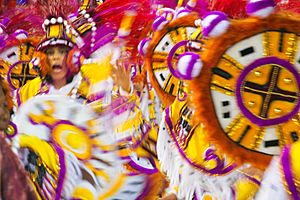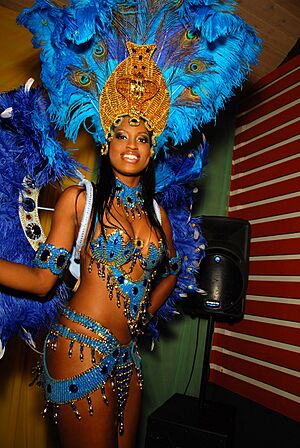Samba facts for kids

Samba is a super fun type of music, dancing, and singing that comes from Brazil. It started becoming popular in the 1920s.
Contents
What is Samba Dance?
Samba is a lively and rhythmic dance from Brazil. It's often danced to music that has a quick, steady beat.
When people dance samba in a ballroom, they usually take three steps for every part of the music. This makes it feel a bit like a different kind of dance.
There are two main kinds of samba dance:
- Ballroom Samba: This is danced with a partner and is popular all over the world.
- Traditional Brazilian Samba: This is often danced by one person, especially during big celebrations like Carnival. In this style, dancers usually take one step for each beat of the music.
Where Did Samba Come From?
The ballroom samba dance started in Brazil in the early 1900s. Many of its dance moves came from a dance called the Maxixe, which was popular around 1910. A book published in France in 1928 even described how to do the samba!
The modern ballroom samba we see today was developed in England. Dancers there took steps they saw in Brazil and adapted them. Now, this version of samba is danced in competitions all over the world.
How is Ballroom Samba Danced?
Ballroom samba is a dance for partners. The way you move doesn't change much, no matter what samba music is playing. Some of the moves come from older Afro-Brazilian dances. These traditional dances were used in special ceremonies.
Ballroom samba is danced to music with a specific rhythm. The basic steps often have a slight bouncing action. This bounce comes from bending and straightening your knees. You bend your knees on the main beats of the music. Samba is known for its constantly changing rhythms, which makes it exciting!
Instruments in Traditional Brazilian Samba
During street Carnivals, musicians play samba music while moving with the dancers. Sometimes they walk, and sometimes they are on a special moving platform.
The music is played with many different instruments:
- Bass drums: These are called surdo drums and keep a steady beat.
- Snare drums: These add a sharp, rattling sound.
- Whistle: This is called an apito (say "a-PEET-oh"). It's used to signal when a section of music starts or ends.
- Other percussion: Many other types of drums and shakers are used.
- Bells: Different kinds of bells add to the rhythm.
Sometimes, the apito whistle will play a rhythm, and then all the other instruments will play a different rhythm in response. This is called a call and response section. Samba songs can also have instrument solos, where one instrument plays a really exciting rhythm! The apito player signals the end of one part and the start of another with a short whistle blast. Samba songs always have clear beginnings and ends.
Ballroom samba music is usually played by regular ballroom dance bands. They might add one or two extra percussion instruments to get that samba feel.
Images for kids
-
"Batuque" (1835), a painting by the German Johann Moritz Rugendas.
See also
 In Spanish: Samba (música) para niños
In Spanish: Samba (música) para niños










